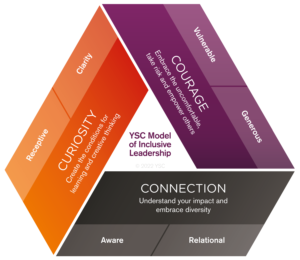Over the last few years, business leaders have stepped up to show their belief in the importance of diversity and inclusion agendas by making public commitments, dedicating money and time to training and development for themselves and their people, and sharing concrete changes designed to lead to a more equitable workplace – and world.
But in a matter of days, through carelessness in our messaging and crisis management, much of that belief and commitment is looking like empty talk.
As we all work hour-by-hour to unravel an intricate web of public health need, shifts in basic daily life, the human, emotional, and psychological dimensions of this crisis, and essential economic considerations, the temptation to ignore all but the most urgent questions is strong. But focus on this massive challenge without use of a diversity and inclusion lens is a potentially fatal mistake. Sidelining identity, diversity, and inclusion leaves essential problem-solving and critical thinking styles on the table, ignores the disproportionate impact of this crisis on identifiable individual and sub-populations, and – at worst – risks the lives and well-being of some members of our businesses and communities.
Why leading inclusively is critical to successful business leadership during the COVID-19 pandemic
We know that the challenges facing us are complex and, yes, unprecedented; we also know that crafting sustainable solutions to complex problems benefits from varied cognitive styles and heightened creativity. And we know that social diversity is a predictor of a group’s innovative thinking and problem-solving.
We also know, though, that introducing creative brainstorming and cultivating alternate perspectives are not great ideas while in the middle of fighting a fire. Crisis demands clear, focused, directive leadership – but it also requires leaders to create conditions for longer-term solutions. Facing only into the problem in front of us without attention to what might be next risks creating even tougher challenge to our people and the business shortly after. The easiest way to preempt those later difficulties: via thoughtful, careful communication now.
Conveying inclusive messages amidst crisis is simpler than it seems: first, remind people that we care about them as people and value them for who they are and what they bring to our businesses; next, acknowledge that we are aware of the potentially disproportionate impact that these challenges might introduce to their lives based on some aspects of their identities and experiences; third, assure them that the perspectives that their identities and experiences enable are critical to the survival and performance of the business and appropriate caring for its people and customers; and fourth, offer resources, ideas, and support to ensure the engagement of these members of our communities now and into the future.
What should we do?
The good news is that we haven’t gotten this all wrong: there is a clear model for how we’ve been successfully attentive to the needs of an identifiable subpopulation of our people, and that is in the resources created and shared for parents of school-age children. Many people working at home for the first time that their school-age children are also at home are managing a rush of feelings with an abundance of resources for online learning, behavior and emotional management, community sharing, and more.
Although there is plenty more that we can and will need to do for parents and children who are sharing their spaces in a new way right now, we can glean easy lessons from what’s gone well already: one, we have acknowledged that being a parent of a school-aged child is an important identity that brings with it a different experience of this crisis and of the world right now; two, we have noted that being a parent may also bring extra challenges that require accommodations to ensure that we can all be at our best for our families and at work; three, we have recognized that we care about, believe in, and need these members of our teams to be able to work to manage through this crisis; and four, we have recognized that additional resources and support, both instrumental and emotional, can ease some of the burden on parents and children and help through this period – personally and professionally.
Where have we gotten it wrong?
Parents are one identifiable sub-population of leaders and employees who have needed thoughtfulness about a core component of their identities to enable them to manage successfully through this time. But there are plenty of others who would benefit from similar consideration:
![]()
Military veterans may be experiencing secondary trauma – psychologically, emotionally, and even physically – from the severity and intensity of this crisis, from the death toll on our communities, and from the use of military language and framing in how our leaders are addressing the public.
![]()
People with chronic illness or severely ill family members may be having trouble accessing medications, regular treatment, or basic services because of redirection of medical services to addressing coronavirus cases.
![]()
Colleagues in addiction recovery may be struggling to manage addictions while under the extreme stress of isolation, and may be challenged by the inability to attend twelve-step meetings or to access other support services while communities are under quarantine.
![]()
People of faith may be challenged by the inability to attend religious services, to visit houses of worship, or to observe celebrations and mourn loss in community – all of which are typically known protective factors for stress management and reduction.
![]()
Asian and Asian-American community members are experiencing heightened attacks, both verbal and physical, as a result of messaging about the origin of the COVID-19 virus in China. These create additional risks to physical and psychological safety as well as increased concern about family members – particularly amidst forced social distancing.
![]()
International colleagues may experience psychological power distance upon finding that support, resources, and even response are geared to the location of the organization’s headquarters, without adequate attention to their experiences in other regions or markets. While Europe and the U.S. have been inundated with COVID-19 response messaging in the past week, colleagues in China have been saturated with it for more than two months.
![]()
African American and other Black community members may be less likely to receive COVID-19 testing than members of other racial groups, potentially contributing further to disproportionate impact on Black communities. Existing racial disparities in diagnosis and treatment of most health issues are presently compounded by inconsistency in testing distribution mechanisms (e.g., Black Americans are significantly less likely to live in a household with access to a car than Americans of other racial identities, making drive-through testing and treatment significantly less realistic).
![]()
Lesbian, gay, bisexual, and transgender community members are statistically more likely to work in industries that have been highly affected by COVID-19, to be poorer than their heterosexual and/or cisgender counterparts, to have gaps in health coverage, and/or to have related health complications (including respiratory issues or chronic illness).
![]()
Rural communities are less likely to have access to testing and to have access to healthcare. While current reports indicate notably greater concentration of COVID-19 in cities, this may be as much a function of limited testing as a function of lesser prevalence.
There are likely plenty of other identifiable sub-populations within all of our businesses who will be in need of differentiated recognition, support, and engagement as we manage through this crisis. Consider, for instance, the needs of individuals with elder care responsibilities; those who are grieving a loss; those who are survivors of domestic violence; those who are living alone; and many more. Think about others who might be specific to your business, to the communities where you live, work, and operate, and even those specific to your customer base. How might they be disproportionately affected by COVID-19?
What can we do now?
Begin by considering your diversity, equity, and inclusion agenda prior to the pandemic. What do you want to be known for as a business? What do you personally want to be known for as a leader? Review your correspondence to date (or lack thereof) and consider, “How can I make sure that our commitment to all of our people, mindful of their range of identities, is clear through all of my communication? How can I create the conditions to avail ourselves of the benefits of inclusion and diversity through this crisis and beyond? How can I provide the right mix of support and engagement for those members of our business community who may be disproportionately affected by COVID-19?” We call this conscious inclusion, and our validated model of successful inclusive leadership demands that leaders demonstrate three characteristics: curiosity, courage, and connection.

To demonstrate courage, show some authentic vulnerability. Acknowledge where you’ve missed or made mistakes in communication so far, and show your commitment to
generously and more carefully considering identity, diversity, and inclusion in your ongoing writing and speaking. Share a bit about how you’re feeling: what parts of your identities are being tested and affected by this crisis? How are you building your own resilience?
Curiosity requires openness, receptivity, and genuine investment in understanding others’ experiences. Ask your team to share with you – what are they going through? What are they finding helpful? What would they like more or less of? How can you incorporate their identities and experiences into your own thinking, planning, and communication?
Connection demands understanding your own perspective and how it is shaped by your identities and experiences, to then enable you to understand and relate to others’ lives and realities. As a leader, your ability to avail yourself of the benefits of the rich diversity of your team is contingent upon your willingness to connect meaningfully with others and to help to meet their needs, emotionally and practically.
Consider how you might share resources that reflect a wide range of life circumstances, need states, and experiences included among your business community. Whether or not recipients of your messages use these resources, they remain a vital part of communicating your values, priorities, and desire to lead inclusively.
While your best results will be achieved if you represent the specific identities and experiences that are essential to your organization, you might start with some of the resources below. The responses that your team members send you will be clear indicators of their belief in your commitment to leading inclusively and to caring deeply about all the full range of diverse experiences and identities in your community. Those businesses that demonstrate community care and a focus on leading inclusively will manage through each stage of this crisis – and hopefully to the other side of it – in a very different state than those that do not.
